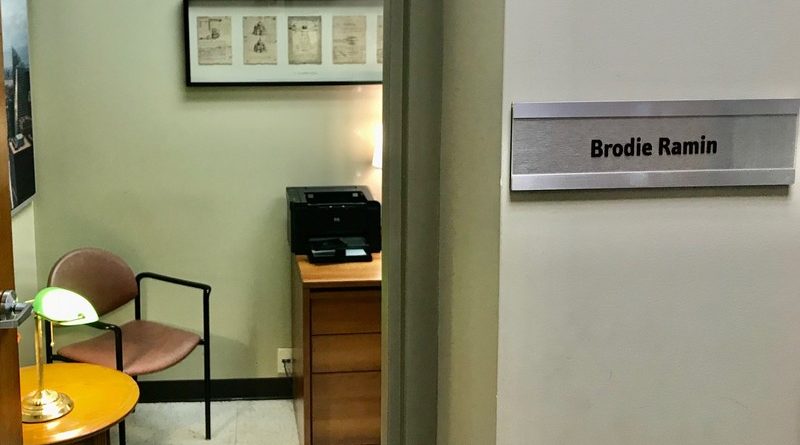BOOK REVIEW
The Age of Fentanyl
Ending the Opioid Epidemic, by Brodie Ramin M.D.
Dundurn, Toronto, 2020
Larry Newman
Brodie Ramin is a medical doctor who has an office at the Sandy Hill Community Health Centre and counsels drug users, primarily users of opioids like fentanyl. He wrote a book, The Age of Fentanyl about opioid drug addiction and the process of recovery. My review of this book is a follow-on to the review of Ben Westhoff’s Fentanyl Inc. in the last issue of IMAGE. Westhoff reveals how fentanyl is a business and tells how it is made, distributed, and sold. Ramin’s book tells about the effects of opioid addiction, particularly fentanyl, and the options for treating it.
Dr. Ramin engages the reader at his first sentences as he tells the story of a young woman, Amber, who has just overdosed on heroin, one of several opioids available on the street. She appeared not to breathe when she was found but Dr. Ramin detected a slow pulse and naloxone was administered. She went from near death to life in a few seconds. That’s the amazing feature of naloxone.
Naloxone doesn’t cure the addiction. But it counters the effect of opioid overdose, allowing the individual’s normal breathing rate to resume. Addiction comes from the repeated application of opioids through the blood stream to various receptors in the brain. When opioids come into contact with these receptors, dopamine or pleasure molecules are released. It’s addicting.
Aside from the addiction itself, there is another hazard: the individual needs more and more opioid to again attain the first pleasurable experience, the “high.” More opioid means a greater activation on the receptors in the brain stem. These brain stem receptors control the most basic of functions in the human body—including respiration. As a user takes more and more opioids to attain that first pleasurable experience, the brain stem receptors may trigger a decrease in respiration, a fatal condition unless there is intervention.
Just as Dr. Ramin and his team intervened to save Amber’s life with naloxone, he counsels and treats patients in the hope that this more indirect and lengthy intervention will prevent them from continuing their addiction. Dr. Ramin tells anecdotes that reveal the variety of contributors to drug addiction: overuse starting with an original pain prescription, depression, homelessness, PTSD, Big Pharma’s huge opioid advertising budget, and many more. It’s not enough to just provide methadone or buprenorphine to the addict who is being treated. One must understand the contributors to the addiction in order to understand the treatment.
Probably the best starting place to begin treatment is a clinic like the Oasis clinic at the Sandy Hill Community Health Centre. One of the advantages of the Supervised Consumption Site located at the SHCHC is that there is the opportunity for a client to talk with a counselor about addiction and treatment, sometimes several times a day. That starts the process of recovery.
There is a relatively simple treatment for opioid addiction—replace a short-acting opioid of possibly unknown strength and contaminants with a long-acting pharmaceutical-grade opioid like methadone or buprenorphine. Each provides relief from opioid withdrawal symptoms and reduces cravings. It activates the same receptors as does heroin or fentanyl but it does it longer and with many fewer risks.

Photo Larry Newman
Dr. Ramin prefers buprenorphine. The first few treatments of buprenorphine will take place in the addiction doctor’s office. When no problems arise, the client will get a prescription that requires going to a pharmacy every day to get the drug. When urine toxicology screening shows that no opioids have been taken for several months, the client may get a prescription requiring only one visit/month to the pharmacy.
At some point down the road a phased reduction will take place and the client will be free of opioids. However, even after avoiding opioids for months or years, some clients will resume their addiction and the recovery process starts over again.
Drug replacement with methadone or buprenorphine is a straightforward and effective way to deal with addiction, even to cure addiction by slowly reducing the dosage of the addicting opioid. Opioid addiction is often only one of the problems that people who use drugs may have. Hepatitis C and HIV are common medical problems that are experienced by drug users and a holistic approach is necessary for effective treatment. Then, there are problems such as homelessness, PTSD, mental illness, and others that an addiction physician will discover and have to deal with.
This addiction doctor, Brodie Ramin, loves his job. His book offers much more information, context, history and advice than this short review can cover. Buy the book. It’s very well written and is very relevant to current drug addiction problems with fentanyl that we are now seeing in Sandy Hill.
